+ Open data
Open data
- Basic information
Basic information
| Entry | Database: EMDB / ID: EMD-9066 | |||||||||
|---|---|---|---|---|---|---|---|---|---|---|
| Title | CryoEM structure of AcrIIA2 in complex with CRISPR-Cas9 | |||||||||
 Map data Map data | SpyCas9-A2a complex | |||||||||
 Sample Sample |
| |||||||||
 Keywords Keywords | CRISPR-Cas / Cas9 / Cas9 inhibitors / anti-CRISPR / AcrIIA2 / bacteriophage / gene editing / HYDROLASE-RNA-VIRAL PROTEIN complex | |||||||||
| Function / homology |  Function and homology information Function and homology informationmaintenance of CRISPR repeat elements / endonuclease activity / defense response to virus / Hydrolases; Acting on ester bonds / DNA binding / RNA binding / metal ion binding Similarity search - Function | |||||||||
| Biological species |  Streptococcus pyogenes M1 GAS (bacteria) / Streptococcus pyogenes M1 GAS (bacteria) /  Listeria phage LP-101 (virus) Listeria phage LP-101 (virus) | |||||||||
| Method | single particle reconstruction / cryo EM / Resolution: 3.4 Å | |||||||||
 Authors Authors | Jiang F / Liu JJ | |||||||||
| Funding support |  United States, 1 items United States, 1 items
| |||||||||
 Citation Citation |  Journal: Mol Cell / Year: 2019 Journal: Mol Cell / Year: 2019Title: Temperature-Responsive Competitive Inhibition of CRISPR-Cas9. Authors: Fuguo Jiang / Jun-Jie Liu / Beatriz A Osuna / Michael Xu / Joel D Berry / Benjamin J Rauch / Eva Nogales / Joseph Bondy-Denomy / Jennifer A Doudna /  Abstract: CRISPR-Cas immune systems utilize RNA-guided nucleases to protect bacteria from bacteriophage infection. Bacteriophages have in turn evolved inhibitory "anti-CRISPR" (Acr) proteins, including six ...CRISPR-Cas immune systems utilize RNA-guided nucleases to protect bacteria from bacteriophage infection. Bacteriophages have in turn evolved inhibitory "anti-CRISPR" (Acr) proteins, including six inhibitors (AcrIIA1-AcrIIA6) that can block DNA cutting and genome editing by type II-A CRISPR-Cas9 enzymes. We show here that AcrIIA2 and its more potent homolog, AcrIIA2b, prevent Cas9 binding to DNA by occluding protein residues required for DNA binding. Cryo-EM-determined structures of AcrIIA2 or AcrIIA2b bound to S. pyogenes Cas9 reveal a mode of competitive inhibition of DNA binding that is distinct from other known Acrs. Differences in the temperature dependence of Cas9 inhibition by AcrIIA2 and AcrIIA2b arise from differences in both inhibitor structure and the local inhibitor-binding environment on Cas9. These findings expand the natural toolbox for regulating CRISPR-Cas9 genome editing temporally, spatially, and conditionally. | |||||||||
| History |
|
- Structure visualization
Structure visualization
| Movie |
 Movie viewer Movie viewer |
|---|---|
| Structure viewer | EM map:  SurfView SurfView Molmil Molmil Jmol/JSmol Jmol/JSmol |
| Supplemental images |
- Downloads & links
Downloads & links
-EMDB archive
| Map data |  emd_9066.map.gz emd_9066.map.gz | 117.3 MB |  EMDB map data format EMDB map data format | |
|---|---|---|---|---|
| Header (meta data) |  emd-9066-v30.xml emd-9066-v30.xml emd-9066.xml emd-9066.xml | 14.6 KB 14.6 KB | Display Display |  EMDB header EMDB header |
| Images |  emd_9066.png emd_9066.png | 45.9 KB | ||
| Filedesc metadata |  emd-9066.cif.gz emd-9066.cif.gz | 6.8 KB | ||
| Archive directory |  http://ftp.pdbj.org/pub/emdb/structures/EMD-9066 http://ftp.pdbj.org/pub/emdb/structures/EMD-9066 ftp://ftp.pdbj.org/pub/emdb/structures/EMD-9066 ftp://ftp.pdbj.org/pub/emdb/structures/EMD-9066 | HTTPS FTP |
-Validation report
| Summary document |  emd_9066_validation.pdf.gz emd_9066_validation.pdf.gz | 524.6 KB | Display |  EMDB validaton report EMDB validaton report |
|---|---|---|---|---|
| Full document |  emd_9066_full_validation.pdf.gz emd_9066_full_validation.pdf.gz | 524.2 KB | Display | |
| Data in XML |  emd_9066_validation.xml.gz emd_9066_validation.xml.gz | 6.5 KB | Display | |
| Data in CIF |  emd_9066_validation.cif.gz emd_9066_validation.cif.gz | 7.4 KB | Display | |
| Arichive directory |  https://ftp.pdbj.org/pub/emdb/validation_reports/EMD-9066 https://ftp.pdbj.org/pub/emdb/validation_reports/EMD-9066 ftp://ftp.pdbj.org/pub/emdb/validation_reports/EMD-9066 ftp://ftp.pdbj.org/pub/emdb/validation_reports/EMD-9066 | HTTPS FTP |
-Related structure data
| Related structure data |  6mcbMC  9067C  6mccC C: citing same article ( M: atomic model generated by this map |
|---|---|
| Similar structure data |
- Links
Links
| EMDB pages |  EMDB (EBI/PDBe) / EMDB (EBI/PDBe) /  EMDataResource EMDataResource |
|---|---|
| Related items in Molecule of the Month |
- Map
Map
| File |  Download / File: emd_9066.map.gz / Format: CCP4 / Size: 125 MB / Type: IMAGE STORED AS FLOATING POINT NUMBER (4 BYTES) Download / File: emd_9066.map.gz / Format: CCP4 / Size: 125 MB / Type: IMAGE STORED AS FLOATING POINT NUMBER (4 BYTES) | ||||||||||||||||||||||||||||||||||||||||||||||||||||||||||||
|---|---|---|---|---|---|---|---|---|---|---|---|---|---|---|---|---|---|---|---|---|---|---|---|---|---|---|---|---|---|---|---|---|---|---|---|---|---|---|---|---|---|---|---|---|---|---|---|---|---|---|---|---|---|---|---|---|---|---|---|---|---|
| Annotation | SpyCas9-A2a complex | ||||||||||||||||||||||||||||||||||||||||||||||||||||||||||||
| Projections & slices | Image control
Images are generated by Spider. | ||||||||||||||||||||||||||||||||||||||||||||||||||||||||||||
| Voxel size | X=Y=Z: 0.83 Å | ||||||||||||||||||||||||||||||||||||||||||||||||||||||||||||
| Density |
| ||||||||||||||||||||||||||||||||||||||||||||||||||||||||||||
| Symmetry | Space group: 1 | ||||||||||||||||||||||||||||||||||||||||||||||||||||||||||||
| Details | EMDB XML:
CCP4 map header:
| ||||||||||||||||||||||||||||||||||||||||||||||||||||||||||||
-Supplemental data
- Sample components
Sample components
-Entire : AcrIIA2 interacting with sgRNA-bound Streptococcus pyogenes Cas9
| Entire | Name: AcrIIA2 interacting with sgRNA-bound Streptococcus pyogenes Cas9 |
|---|---|
| Components |
|
-Supramolecule #1: AcrIIA2 interacting with sgRNA-bound Streptococcus pyogenes Cas9
| Supramolecule | Name: AcrIIA2 interacting with sgRNA-bound Streptococcus pyogenes Cas9 type: complex / ID: 1 / Parent: 0 / Macromolecule list: all |
|---|
-Supramolecule #2: sgRNA-bound Streptococcus pyogenes Cas9
| Supramolecule | Name: sgRNA-bound Streptococcus pyogenes Cas9 / type: complex / ID: 2 / Parent: 1 / Macromolecule list: #1-#2 |
|---|---|
| Source (natural) | Organism:  Streptococcus pyogenes M1 GAS (bacteria) Streptococcus pyogenes M1 GAS (bacteria) |
-Supramolecule #3: AcrIIA2
| Supramolecule | Name: AcrIIA2 / type: complex / ID: 3 / Parent: 1 / Macromolecule list: #3 |
|---|---|
| Source (natural) | Organism:  Listeria phage LP-101 (virus) Listeria phage LP-101 (virus) |
-Macromolecule #1: Single guide RNA (116-MER)
| Macromolecule | Name: Single guide RNA (116-MER) / type: rna / ID: 1 / Number of copies: 1 |
|---|---|
| Source (natural) | Organism:  Streptococcus pyogenes M1 GAS (bacteria) Streptococcus pyogenes M1 GAS (bacteria) |
| Molecular weight | Theoretical: 37.642258 KDa |
| Sequence | String: (GTP)GCGCAUAAA GAUGAGACGC GUUUUAGAGC UAUGCUGUUU UGAAAAAAAC AGCAUAGCAA GUUAAAAUAA GGCUAG UCC GUUAUCAACU UGAAAAAGUG GCACCGAGUC GGUGCUU |
-Macromolecule #2: CRISPR-associated endonuclease Cas9
| Macromolecule | Name: CRISPR-associated endonuclease Cas9 / type: protein_or_peptide / ID: 2 / Number of copies: 1 / Enantiomer: LEVO / EC number: Hydrolases; Acting on ester bonds |
|---|---|
| Source (natural) | Organism:  Streptococcus pyogenes M1 GAS (bacteria) Streptococcus pyogenes M1 GAS (bacteria) |
| Molecular weight | Theoretical: 158.685828 KDa |
| Recombinant expression | Organism:  |
| Sequence | String: MDKKYSIGLD IGTNSVGWAV ITDDYKVPSK KFKVLGNTDR HSIKKNLIGA LLFDSGETAE ATRLKRTARR RYTRRKNRIC YLQEIFSNE MAKVDDSFFH RLEESFLVEE DKKHERHPIF GNIVDEVAYH EKYPTIYHLR KKLVDSTDKA DLRLIYLALA H MIKFRGHF ...String: MDKKYSIGLD IGTNSVGWAV ITDDYKVPSK KFKVLGNTDR HSIKKNLIGA LLFDSGETAE ATRLKRTARR RYTRRKNRIC YLQEIFSNE MAKVDDSFFH RLEESFLVEE DKKHERHPIF GNIVDEVAYH EKYPTIYHLR KKLVDSTDKA DLRLIYLALA H MIKFRGHF LIEGDLNPDN SDVDKLFIQL VQTYNQLFEE NPINASGVDA KAILSARLSK SRRLENLIAQ LPGEKKNGLF GN LIALSLG LTPNFKSNFD LAEDAKLQLS KDTYDDDLDN LLAQIGDQYA DLFLAAKNLS DAILLSDILR VNTEITKAPL SAS MIKRYD EHHQDLTLLK ALVRQQLPEK YKEIFFDQSK NGYAGYIDGG ASQEEFYKFI KPILEKMDGT EELLVKLNRE DLLR KQRTF DNGSIPHQIH LGELHAILRR QEDFYPFLKD NREKIEKILT FRIPYYVGPL ARGNSRFAWM TRKSEETITP WNFEE VVDK GASAQSFIER MTNFDKNLPN EKVLPKHSLL YEYFTVYNEL TKVKYVTEGM RKPAFLSGEQ KKAIVDLLFK TNRKVT VKQ LKEDYFKKIE CFDSVEISGV EDRFNASLGT YHDLLKIIKD KDFLDNEENE DILEDIVLTL TLFEDREMIE ERLKTYA HL FDDKVMKQLK RRRYTGWGRL SRKLINGIRD KQSGKTILDF LKSDGFANRN FMQLIHDDSL TFKEDIQKAQ VSGQGDSL H EHIANLAGSP AIKKGILQTV KVVDELVKVM GRHKPENIVI EMARENQTTQ KGQKNSRERM KRIEEGIKEL GSQILKEHP VENTQLQNEK LYLYYLQNGR DMYVDQELDI NRLSDYDVDH IVPQSFLKDD SIDNKVLTRS DKNRGKSDNV PSEEVVKKMK NYWRQLLNA KLITQRKFDN LTKAERGGLS ELDKAGFIKR QLVETRQITK HVAQILDSRM NTKYDENDKL IREVKVITLK S KLVSDFRK DFQFYKVREI NNYHHAHDAY LNAVVGTALI KKYPKLESEF VYGDYKVYDV RKMIAKSEQE IGKATAKYFF YS NIMNFFK TEITLANGEI RKRPLIETNG ETGEIVWDKG RDFATVRKVL SMPQVNIVKK TEVQTGGFSK ESILPKRNSD KLI ARKKDW DPKKYGGFDS PTVAYSVLVV AKVEKGKSKK LKSVKELLGI TIMERSSFEK NPIDFLEAKG YKEVKKDLII KLPK YSLFE LENGRKRMLA SAGELQKGNE LALPSKYVNF LYLASHYEKL KGSPEDNEQK QLFVEQHKHY LDEIIEQISE FSKRV ILAD ANLDKVLSAY NKHRDKPIRE QAENIIHLFT LTNLGAPAAF KYFDTTIDRK RYTSTKEVLD ATLIHQSITG LYETRI DLS QLGGD UniProtKB: CRISPR-associated endonuclease Cas9 |
-Macromolecule #3: Anti-CRISPR protein AcrIIA2
| Macromolecule | Name: Anti-CRISPR protein AcrIIA2 / type: protein_or_peptide / ID: 3 / Number of copies: 1 / Enantiomer: LEVO |
|---|---|
| Source (natural) | Organism:  Listeria phage LP-101 (virus) Listeria phage LP-101 (virus) |
| Molecular weight | Theoretical: 14.167594 KDa |
| Recombinant expression | Organism:  |
| Sequence | String: MTLTRAQKKY AEAMHEFINM VDDFEESTPD FAKEVLHDSD YVVITKNEKY AVALCSLSTD ECEYDTNLYL DEKLVDYSTV DVNGVTYYI NIVETNDIDD LEIATDEDEM KSGNQEIILK SELK |
-Experimental details
-Structure determination
| Method | cryo EM |
|---|---|
 Processing Processing | single particle reconstruction |
| Aggregation state | particle |
- Sample preparation
Sample preparation
| Buffer | pH: 8 Details: 30 mM Tris-HCl, pH 8.0, 150 mM sodium chloride, 5 mM DTT, 0.1% glycerol |
|---|---|
| Grid | Model: C-flat-2/0.5 4C |
| Vitrification | Cryogen name: ETHANE / Chamber humidity: 100 % / Chamber temperature: 277 K / Instrument: FEI VITROBOT MARK II |
| Details | SpyCas9-sgRNA-AcrIIA2 complex |
- Electron microscopy
Electron microscopy
| Microscope | FEI TITAN KRIOS |
|---|---|
| Image recording | Film or detector model: GATAN K2 SUMMIT (4k x 4k) / Average electron dose: 43.2 e/Å2 |
| Electron beam | Acceleration voltage: 300 kV / Electron source:  FIELD EMISSION GUN FIELD EMISSION GUN |
| Electron optics | Illumination mode: FLOOD BEAM / Imaging mode: BRIGHT FIELD |
| Experimental equipment |  Model: Titan Krios / Image courtesy: FEI Company |
- Image processing
Image processing
| Startup model | Type of model: EMDB MAP |
|---|---|
| Final reconstruction | Resolution.type: BY AUTHOR / Resolution: 3.4 Å / Resolution method: FSC 0.143 CUT-OFF / Number images used: 263270 |
| Initial angle assignment | Type: MAXIMUM LIKELIHOOD |
| Final angle assignment | Type: MAXIMUM LIKELIHOOD |
 Movie
Movie Controller
Controller





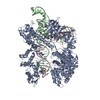

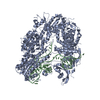
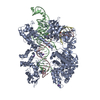
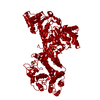

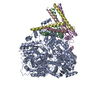


 Z (Sec.)
Z (Sec.) Y (Row.)
Y (Row.) X (Col.)
X (Col.)






















